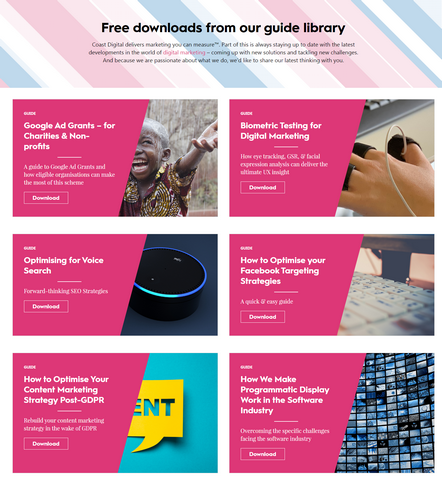There’s a tendency for people to see content as something of a necessity – something that has to be done, that can be done by anyone, and that doesn’t operate within the same kind of rigorous parameters that can be applied to other forms of digital marketing.
When we talk about content marketing as a discipline, it’s vital that we move away from this kind of mindset. The reality is that content marketing can be subjected to the same level of analytical rigour as any digital marketing – the best content marketers do this to understand how to evolve and adapt their strategy based on what that analysis is telling them.
In this article I’ll dig into:
- Why the need for better measurement in content marketing is increasing.
- How you can approach content marketing measurement.
- How you can use what your numbers are telling you to get better at content marketing.
Why measuring content is important
I came across a few stats recently that build a really compelling case for better data in content marketing.
“60% of marketers create at least one piece of content every working day.” –eMarketer
I put this statistic to the test when I was speaking at CIM’s Content Marketing Masterclass – I got a room full of marketers to put their hands up if they created a piece of content every working day, and maybe 50% of the room put their hands up. When I increased the timescale to a week, it went up to about 80%.
So, while I wasn’t quite able to validate this 60% figure, we can see that amongst that sample there’s still a significant number of people spending a fair bit of time creating content.
“39% of marketing budget is spent on content marketing by the most effective B2B marketers” –TopRankBlog
On top of a huge time commitment, we can see here there is also a significant – and I would suggest growing – monetary commitment to content marketing.
The best way of looking at this is as follows: If someone was suggesting they spend 39% of a marketing budget on PPC or display, you’d expect to know what those channels were driving in terms of results and return. On that basis alone, content marketers need to be able to stand up to the same level of scrutiny – particularly if we expect to continue to compete for this level of budgetary support.
If content is going to continue to become a bigger part of what we do, and therefore consume more time and resource, we need to be able to effectively measure how successful it is.
The fundamentals of measurement in content marketing

The first thing to do is to determine what the distinct strands of your content marketing strategy are – these could be, for example, blogging, whitepapers, webinars and live social media Q&As. Next, you need to determine what the objectives of each of those strands are.
The vital thing to understand here is that you can’t expect every piece of content to do everything. Much like individual marketing channels, different kinds of content interact with the users at different points in their journey – a single piece of content can’t be expected to succeed at every stage of the marketing funnel.
By differentiating the objectives of each type of content you create, you can get a better understanding of whether those pieces of content are succeeding at the level you need them to.
For example, if we expect a blog article to drive leads, we might consider the blog to be a failure due to relatively low performance numbers. However, if we view the blog correctly – e.g. as an engagement tool that exists to interact with and engage users at the very start of their journey with us a brand – then we might instead find that the blog is doing extremely well at creating these all-important initial interactions.
The inverse is also likely true. Whitepapers are unlikely to pull as many first-time visitors, but are far more likely to encourage an exchange of data – and therefore a lead.
Getting a read on performance

Once we understand what these objectives are, you can start to look at the kinds of metrics you can use to measure them. Some are obvious – in the whitepaper example above, the number of downloads each whitepaper has received is a clear measurement we can take.
However, there are other things that are worth looking into, such as:
- How many downloading users opted in for ongoing marketing and comms?
- Where did those downloading users come from?
- Did they come exclusively from channels you are promoting the whitepaper on, or are there are any surprises? (For example, significant download numbers from referral traffic.)
- How many times did users visit the site before making a download?
- How many users have returned to the site and taken further action after making a download?
- How have your sales team found the quality of those downloading users they have contacted?
This isn’t necessarily an exhaustive list – nor will you always have the ability to measure all of these things. This serves as a demonstration of the levels of analysis we can do on our content marketing. By measuring all, or even some, of these things consistently across all of the individual pieces of content within a strand of content marketing activity, we give ourselves the ability to understand performance and make decisions based on that understanding.
Making continuous improvement part of your content marketing strategy
Measurement is great – as I said before, it is vital for content marketing to be able to prove its own worth, and by having concrete numbers to report on (and show improvement in), we can go a long way to doing that.
However, I would also say that measurement is only step one. The real value comes not only in reporting on identifiable metrics, but in using those metrics to understand how we can improve performance in the future.
As I mentioned above, having consistent measurements across content that lives within a single strand is vital. You need that consistency to give your reporting context, but also to allow you to make these kinds of strategic analyses.
Taking engagement content as an example, if I know that I want to see blog articles pulling traffic to the site – through organic and social perhaps – then I should be measuring this individually for each blog article I produce.
Once I have this information, it’s then possible to do an analysis. By pulling these measurements for all of the blogs over a given period, you can create a benchmark. As an example, this could be the average number of entrances from organic search per article.
With this benchmark set, it’s now time to look for the articles that deviate from this benchmark. Both good news and bad news stories are welcome here – failure is just as useful as success when it comes to ongoing improvement.
Once the outliers have been identified, it’s time to evaluate why they have done so well (or so badly). Are there any clear trends that separate the good from the bad? If there are, then you can use those differences to test a new approach in future. Lean into the qualities that make the good pieces of content good, and steer away from the qualities that are present in poor performing content but not in the stronger examples.
Then, re-run the analysis in three months’ time. Have things improved? Has your average increased? Have the pieces of content produced since you took the benchmark performed better or worse than those from before?
All of this can help you constantly learn and evolve your content marketing strategy, and continue to push for better success – and therefore further justify the marketing budget that is going towards your content marketing activity.
Let’s talk about a strategic approach to content marketing
As I suggested earlier, content is not something you can ‘just do’. Content is an integral part of almost all tranches of digital marketing – whether it’s the copy in your email, the strapline at the front of your video asset, or the topic you’re trying to drive leads from with your latest whitepaper.
Ultimately, a fully informed, data-driven, strategic approach to content marketing will provide you with better results for your budget.
That’s what we do here at Coast Digital – it’s how we market ourselves (as you’ll see if you drop in and check out our selection of digital marketing guides.)
If you’d like to find out how we can apply our strategic expertise to help you get more out of your content marketing budget, then get in touch with us today.

